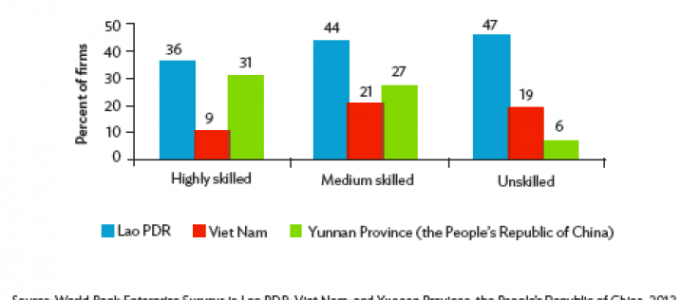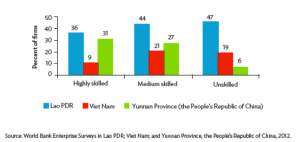Lao PDR: The Labor Shortage
Labor and Skills shortage is one of 4 particular hurdles faced by SME in Lao PDR, according to our report “Business Formalization in Lao PDR“. The post looks at causes and the impact on firms’ competitiveness and the economy.
Labor and Skills Shortage
A clear finding of this study is that shortages of labor and skills are among the biggest constraints facing the private sector in the Lao PDR. Whereas a shortage of skilled labor is a challenge common to many developing countries, the Lao PDR also lacks an adequate supply of unskilled labor.
This finding is based on interviews conducted with large firms, SMEs, business associations, development organizations, and government officials, as well as on the latest data from a World Bank survey of firms. Nearly every interviewee highlighted labor shortages as one of the biggest constraints – and often the biggest constraint – on growth for their firm or, more generally, the private sector.
Causes of Labor Constraint
The underlying causes of labor shortages are interrelated and involve challenges with education, productivity, wages, and the migration of workers to Thailand.
Lack of Unskilled Labor
With about two-thirds of the workforce stuck in low-productivity jobs in agriculture, and chronic labor shortages in other sectors of the economy, it is perhaps surprising that there has not been a large movement of labor out of agriculture and into manufacturing and services – at least not to the extent experienced in comparable countries at similar stages of development.
There are three reasons for this weak migration trend.
First, the low productivity of agriculture means that more workers are needed to stay on the farm. One of the key drivers of rural – urban migration flows in other countries has been dramatic improvements in agriculture productivity, which has freed up workers to move to the cities for work. In the Lao PDR, however, improvements in the productivity of agriculture have been more modest (World Bank 2014b).
Second, the financial incentives for workers to move out of agriculture and into Lao PDR manufacturing are not particularly strong due to low labor productivity – and therefore wages – in manufacturing. Labor productivity in the Lao PDR’s manufacturing sector is about three times that of its agriculture sector. By contrast, labor productivity in Thailand’s manufacturing sector was 15 times that of its agriculture sector in 1986 (the start of its decade-long, rural-urban migration boom), while in Viet Nam it was about four times in the 1990s and six times in the 2000s (World Bank 2014b). This low productivity hinders manufacturing firm’ capacity to offer attractive wages. As a result, the wage premium in Lao PDR manufacturing does not appear to be large enough to incentivize people to move off the farm in sufficient numbers (World Bank 2014b).
Third, a large number of rural residents are leaving their farms, but a significant proportion of them are migrating south of the border. While farmers from northern Lao PDR generally migrate to Vientiane and other urban centers in the Lao PDR, many rural workers in central and southern Lao PDR are attracted by the higher wages offered in Thailand. A secondary-educated Lao farmer earning KN4,100 ($0.51) per hour can move out of agriculture and earn KN7,450 ($0.93) by staying in Lao PDR, or else move to Thailand and earn KN12,600 ($1.58). Given the similarities between the two neighboring countries in terms of language, religion, and culture, compared to the typical migrant worker experience, migrants from the Lao PDR find it relatively easy to work and live in Thailand.
Lack of Skilled Labor
While unskilled labor shortages are driven by population, migration, productivity, and relative wages, the underlying causes of an inadequately skilled workforce relate to deficiencies in education, training, and labor market information.
Poor foundational skills (literacy and numeracy) are a function of a lack of early childhood education, the poor quality of primary and secondary education, and high dropout rates (particularly in rural areas) in primary school, and between primary and secondary school.
As foundational skills are the building blocks for higher learning, the low levels of literacy and numeracy make it difficult for postsecondary students to acquire the technical, vocational, and cognitive skills required for the workforce. These difficulties are exacerbated by the generally poor quality of vocational training and higher education, which is related to deficiencies in resourcing, teaching methods, teacher qualifications, and course curricula. In addition, there appears to be a mismatch between what students are studying and what employers are looking for, with an oversupply of university graduates with business degrees and an undersupply of university and technical and vocational education and training graduates with more technical skills (such as engineering).
The absence of an effective labor market information system in the Lao PDR means that students, parents, education providers, and policymakers have an inadequate understanding of the types of occupations and skills in greatest demand.
Finally, restrictions on the use of foreign workers make it more difficult for firms to cover the skills gaps that exist in the Lao PDR.
Impact of Labor Constraint
The lack of skilled and unskilled labor limits private sector growth in several ways – firms’ growth, firms’ productivity and an increase in labor costs.
Most directly, labor shortages make it difficult for manufacturing and services firms to take advantage of new opportunities to expand their activities or meet growing demand for their products or services. For example, many garment firms would like to be running more production lines and report having to turn away orders because they do not have sufficient machine operators (World Bank 2012). Some businesses interviewed for this study indicated they cannot expand their business or open new stores at the pace they would like to because they cannot find enough supervisors or managers. Similarly, well-managed SEZs in good locations and with adequate supporting infrastructure (such as the SEZ in Savannakhet) have the potential to employ tens of thousands of Lao PDR nationals over the next few years, but their ability to fulfil this potential may be constrained by a lack of low-skilled workers.
In addition, difficulties in finding skilled labor mean that firms are forced to employ inadequately skilled workers. This negatively impacts firms’ productivity, profitability, and international competitiveness.
Labor shortages are contributing to dramatic increases in labor costs. According to the World Bank’s Enterprise Surveys, from 2009 to 2012, real labor costs per worker rose by about 65% in manufacturing firms and 80% in services firms. Combined with weak growth in value added per worker over that period – especially in manufacturing, which is more constrained in passing on rising labor costs – the median return on manufacturers’ sales has declined steeply from nearly 40% to less than 20%. At the same time, costs have risen strongly for services and manufacturing firms (from about 25% to more than 70%). Rapidly rising labor costs may harm the international competitiveness of Lao firms and make it more difficult to develop the non-resource private sector.
As with many labor market issues, there are few quick fixes to the challenge of an inadequate supply of skilled and unskilled labor. While some potential interventions could partly alleviate this constraint, significant improvement will require longer-term planning and resources.
Other EMC posts on Lao PDR:


Comments are closed.